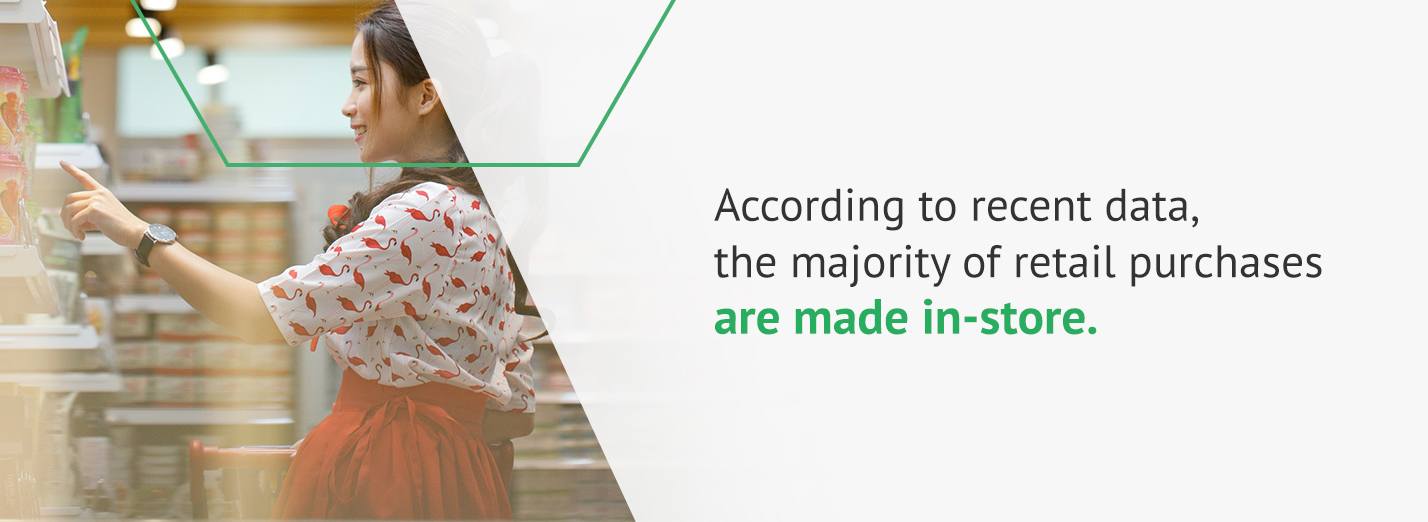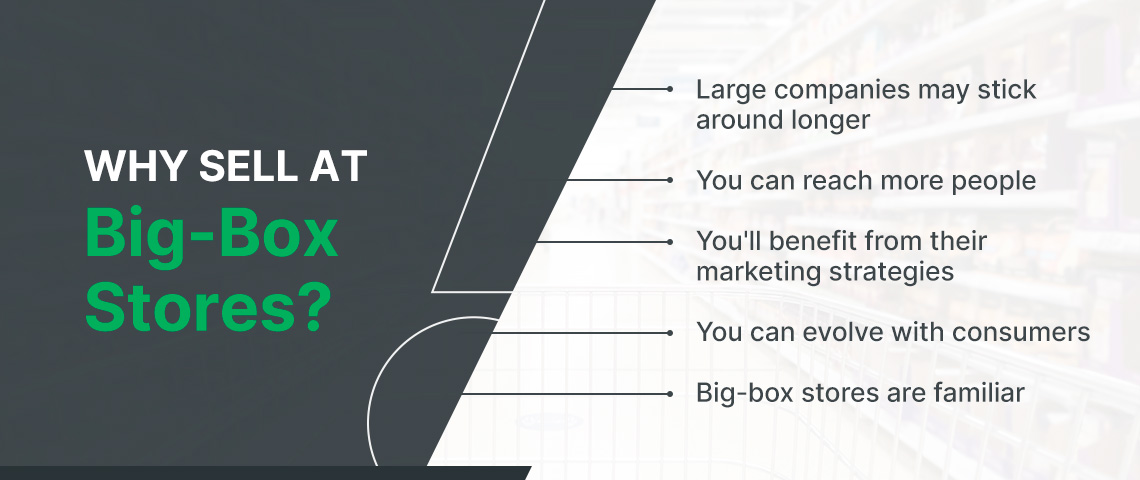Chapter 1: Why Market Your Products in Big-Box Stores?
It’s hard to picture a world without big-box stores. In the past, families anticipated trips to these new enormous stores filled with discounted merchandise. They could spend hours shopping and gathering just about everything they needed for their homes.
Things aren’t much different today, and big-box stores continue to grow despite fears that consumers are spending less. Even as online shopping becomes more popular, people still prefer to shop inside stores. For example, according to recent data provided by the U.S. Census Bureau, most retail purchases are made in-store.
Consumers prefer shopping in-store for various reasons, and big-box retailers offer prices customers are willing to pay. When it comes to stocking up on consumables, big-box stores are hard to beat.
By getting your product into a big-box store, you get to be where your potential customers are shopping. You may also get to enjoy the advantage of making your product available on a retailer’s website, potentially getting your item seen by millions of people.
If you’re an entrepreneur, it’s worth weighing the pros and cons of getting your product on the shelves at major retailers. This chapter explores both the advantages and disadvantages of retail outlets and reasons to sell your product at big-box stores.
What Are Physical Markets?
In general, a market is a place where buyers can purchase goods or services from a seller. The market may be physical, like a retail store. A physical market allows consumers to meet sellers face-to-face.
Physical retail stores are also called brick-and-mortar stores. According to Statista, in 2023, there were 1.07 million retail establishments throughout the U.S., a number that continues to rise.
Physical Retail vs. Online Retail
Why do consumers continue to shop in stores when it’s so easy to make purchases online? Here are some of the advantages of physical markets and how they can benefit your brand:
- Consumers can touch the product: Consumers may be more likely to purchase your product if they can hold it in their hands first. Recent research reveals that 57% of customers want to see, touch and feel items before they make a purchase.
- There’s an easier return process: Customers appreciate returning items in a store rather than sending them back to the seller. Some customers may also prefer face-to-face service rather than deal with the hassle of contacting sellers online or over the phone. When customers know they can quickly return a product, they can try a new brand with confidence.
- Customers are more likely to make an impulse buy: Consumers are more likely to make an impulse purchase in-store than online. Research shows that 8 out of 10 impulse buys are made in a brick-and-mortar store.
- Physical markets enable discovery: Generally, when people shop online, they search for a specific item and ignore everything else. However, when people shop in stores, they are more likely to browse, discover a new product and toss it in their carts.
Online stores and physical stores certainly have distinct advantages that’ll keep both types of markets up and running. If you sell your product in a big-box store, you may be able to enjoy the best of both worlds since many stores like Walmart and Target also offer online shopping and convenient options such as curbside pickup.
Why Sell at Big-Box Stores?
You may be wondering why it’s a good idea to reach major retailers instead of mom-and-pop shops. Although there are benefits to working with a small business, such as more flexible store rules, it’s worth considering the advantages of choosing a big-box store as your retail partner:
- Large companies may stick around longer: According to the Chamber of Commerce, only 50% of small businesses survive after five years. Although big-box stores aren’t immune to the retail market’s volatility, it may be comforting to know that some stores like Walmart have been around for decades and bring in billions of dollars a year.
- You can reach more people: Most people shop at big-box stores or know they exist. If you ask someone if they’ve ever heard of Target, for example, it’s highly likely they know what you’re talking about. Smaller stores, however, aren’t visited by as many people and don’t have the same reach.
- You’ll benefit from their marketing strategies: Big-box retailers can afford to advertise their company and draw people into their stores. The more people they attract, the more it can benefit you.
- You can evolve with consumers: Big-box stores have more money to invest in their stores than smaller retailers. That means they can grow with consumer shopping habits and needs. For example, big-box stores might offer online shopping, self-checkout and curbside pickup. Large retailers can also afford to adopt new technologies to make the customer experience even more convenient.
- Big–box stores are familiar: People like familiar things, from their food to the places they shop. Big-box stores are found all over the country, and consumers know what to expect with each location. Familiarity is especially crucial to consumers buying a product for the first time.
Best Products for Big-Box Stores
Some items, like handcrafted goods or antiques, aren’t meant to be sold in large volumes at low prices. Likewise, certain specialty products belong in small niche stores rather than big-box markets.
However, some products appeal to a mass audience and can be produced in large quantities quickly. These types of goods are ideal for big-box stores like Target or Whole Foods Market. To determine if your product makes the cut, consider if your merchandise is in demand, profitable and consumable. Major retailers thrive on selling consumer packaged goods and often think of strategic ways to encourage impulse buying.
To get your product into a top retailer, consider if you have items that people are likely to buy on impulse, such as:
- Food
- Beer, wine and liquor
- Pharmacy products
- Books and music
- Pet food and supplies
Also, consider what people prefer to buy in-store rather than online. Many consumers favor buying groceries, vehicles and clothes in person.
Overall, big-box stores are looking for new products that will help them stay on top of trends and bring a profit. So, if you have a great product people love to use and want to buy again, you may be the kind of business partner a major retailer seeks.
If you’re ready to learn more about custom displays designed especially for big-box stores, contact Creative Displays Now today!
Table of Contents
- How to Get Your Product Into Big-Box Stores
- Chapter 1: Why Market Your Products in Big-Box Stores?
- Chapter 2: How to Market Your Product to Retailers
- Chapter 3: Find the Right Big-Box Store for Your Products
- Chapter 4: How to Approach Retail Stores to Sell Your Product
- Chapter 5: Get Your Products in Stores With Custom Displays


